AMERICAN ESKIMO DOG HISTORY
by Terry Thistlethwaite
The American Eskimo Dog, nicknamed Eskie, was originally the white colour variety of German Mittel (Middle size) and Kleine (Small size) Spitz that came to the US and Canada from Europe over a century ago. The early history of the AED, therefore, is the history of the German Spitz, a breed (now breeds) that is still with us, and being shown today in many countries throughout the world. German Spitz are represented by five size varieties which were eventually deemed separate breeds:
"Wolf Spitz" (around 18" tall),
now known in most countries as the Keeshond;
"Gross Sptiz" or "Giant Spitz"(around 16");
"Mittel Spitz" or "Medium Size Spitz" (around 14")
from which we get the Standard AED;
"Klein Spitz" or "Small Spitz", (around 12")
from which we get the Mini and Toy AED;
and the smallest
"Zwerg Spitz" or "Toy Spitz", (under 8.5") now commonly
known as the Pomeranian.
The classification of dog breeds known as Spitz are often called the Most Primitive of breeds because they most closely resemble the first domestic dogs descending from their wolf ancestry. As such, these original Spitz dogs are considered by many to be the forebears of all modern breeds of dogs. Being that there are, in fact, several groups of Spitz dogs originating in different parts of the world, it can be somewhat confusing to have basically unrelated breeds carry the moniker of Spitz. Therefore it is important to stress that it is solely the
German Spitz breed from which the American Eskimo Dog originated. . .
In what is now northern Germany and Denmark, homes that
were built centuries ago were supported on stilts, signifying that the area was primarily swampland or peat-bog.. Those ancient swamp areas have proven an excellent preservation material, giving modern excavators detailed insight on their former inhabitants. Included in those excavations are many of the small Spitz dogs that were clearly kept as companions, watchdogs, and small farm herders.
Because small European wolves were known to scavenge thru these farms and villages, the white color Spitz, even back then, seems to have been a preferred colour for these dogs, as it clearly distinguished him from the wolves even from a distance. The name Mistbeller (literally, dung heap barker) was the name of the dogs back then, signifying that they would typically
climb to a high point on the property and sound a warning when necessary. These small family farm dogs had to, by the nature of their environment, be responsible for the many tasks
that would be taken on by multiple types of dogs in more affluent and open areas. Primarily, they were part of the family as companion dogs, and, as such, took on whatever role was needed under a given circumstance. Performing watchdog
activities, varmint chasing, small flock gathering, carriage dog duties, and the balancing act of maneuvering thru the peat bogs resulted in multi tasking abilities that are ingrained in
the breed even down to this day.
Combining high intelligence, an energetic nature,
a lithe frame, and keen interest in the activities of their human family members, they became the easy choice of both Russian and American circus's in later times, as well as carriage dogs, barge dogs, and eventually hearing, alert, and therapy dogs.
When German immigrants brought the dogs to the Americas, U.S. and Canadian fanciers particularly chose the smaller, mid size, and the white dogs as favored varieties. Breeding those
dogs exclusively, they eventually sought to have them recognized as a separate breed from what was by then known as the German Spitz. It was Mr. and Mrs. F.M. Hall who initially chose the name "American Eskimo". It was, in fact, their kennel name. The UKC officially recognized the breed in 1913, followed later by the AKC and finally the CKC. Most Eskies in the US today are still registered with the UKC, and many now with the AKC as a second registry. It is noteworthy that breeders and fanciers of the American Eskimo Dog were, until fairly recently, content with having the breed recognized by and
registered with only the UKC. While this organization satisfied the needs of the fancy as regards registration, pedigree keeping, and show venues, the fact that it is not considered the
"primary" registry in the U.S. may have served to
keep the existence of the AED as a pure breed basically unknown to other registries throughout the world, and it's history erroneously regarded as obscure. It is noteworthy too, that the AHBA, American Herding Breeds Assn, recognizes the
AED as a breed with a documented history of herding. Eskies are therefore eligible to compete in all AHBA herding events.
From the U.S..and Canada, AED's were imported into Japan in the early part of the twentieth century, where the breed name fell into disfavor during the second world war. Eskies in Japan were thus re-named Japanese Spitz, and have recently gained popularity under that name as exports to Europe, Australia, and the British Isles. Almost comically, they have most recently seen their way back into the U.S. under the "new" name, and many fanciers unfamiliar with the history are heralding their "Japanese Spitz" as a "rare new" breed in this country, falsely said to be descended, not from Eskies, but Samoyeds! Even the United Kennel Club, the original registering organization for the American Eskimo Dog, is accepting the renamed Eskie as a "new breed" despite both historical documentation and obvious phenotype proving the "two breeds" are actually one and the same.
Whatever the preferred name, all Eskies are descended from
the same dogs we've known for centuries as the peat-moss
dogs and Mistbeller. The Russian Circus Dogs, also descended from these, provide a more recent history, and it is significant that the first dog documented to walk a tight rope was, in fact,
an AED by the name of Stout's Pal Pierre, associated with the U.S. Barnum and Bailey Circus. Another notable breed member was the Russian "Space Dog" Belka -- who flew on Sputnik 5, and, along with Strelka (likely an Eskie mix and Mom to
Carolyn Kennedy's Pushinka) has the distinction of being the first safely returned space traveler.
Notably, the breed does not share a common ancestry with the Samoyed, and the only Samoyed crosses that have been done were in recent years by unscrupulous breeders who were
unsanctioned in their actions. Any idea that the Eskie should appear as a "smaller version" of the Sammy is unsubstantiated by either the breed's history, or the breed's standard. As a true German Spitz, however, it does share a common ancestry with both the Pomeranian and the Keeshonden. American Eskimos
reasonably should appear more as a white variety, in appropriate size, of either of these breeds, than as a "small Samoyed".
"Eskies", as they're commonly referred to in the U.S. today, are very intelligent, highly social little dogs (and they're all "little"; the Toy being around ten pounds,the Mini being around seventeen pounds, and the Standard being around twenty five pounds) who need to be with their people (no outside life for this breed!) and are generally somewhat aloof toward non-family members. As the breed was specifically
developed over many hundreds of years to be a highly trainable, closely bonded Companion Dog able to do "a little bit of everything" on family farms throughout Northern and Eastern Europe,. they remain today to be extremely people oriented and highly bonded to their humans. They therefore detest being routinely left alone, having no job to do, and being expected to behave as other than a full fledged family member.
Standard sized AED's are typically more suited
to young families as they are sturdier than the smaller varieties. Toys are too small for young children, and a knowledgeable breeder or rescuer will not generally place one in a family with a small child. Some Minis may be suited to older children, depending on the individual dog and family. All Eskies need socialization in their early months, and must be introduced to gentle and well supervised children at an early age if they are to be comfortable and confident with them later on.
True to it's heritage, an AED requires a human or family that is fully committed to understanding the intelligent nature of this breed, as intense communication with this dog is absolutely essential to the happiness of both the Eskie and his owner..
While in earlier times, understanding domestic animals was a given, being that it was essential for human survival, our society has lapsed into a state whereby it is only the minority who actually cultivate such empathy. It is all too common today that an Eskie is acquired by someone who doesn't have a clue as to how a particularly bright, working dog thinks, and they are too often put into the hands of similarly clueless individuals who have deemed themselves to be "trainers". Such folks typically give up on these brilliant dogs, even labeling them "dumb" when it is truly the amateur and ignorant methods being used that fail to bring the desired response. In too many cases, these placements fail because the dog is simply smarter than the human has bothered to cultivate the insight to understand.
For an individual or family willing to rise to the challenge of
living with a genuinely brilliant, fun loving and exceptionally devoted little dog, the American Eskimo Dog can be the very best choice possible. Their beautiful coat is surprisingly easy to care for and maintain with weekly brushing, and despite the white color, bathing is seldom necessary as the dog seems to have a natural ability to repel dirt. Another interesting quality of this breed is that it is considered a particularly low allergen dog, and many who are allergic to dogs in general find they are able to live quite comfortably with an Eskie in the home.
From the peat bogs of old Denmark and the backs of horses in the Russian circus, our present day American Eskimo Dog has arrived very much unchanged in both beauty and demeanor.
It cannot be overly stressed that his greatest desire is to be with you and to have a job to do for you. Once you bring him into your life, he will walk effortlessly into your heart. Often called "The Dog Beautiful", you will soon learn that his beauty emanates from within.
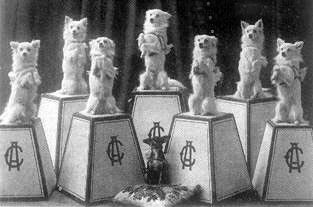
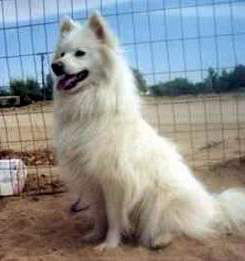
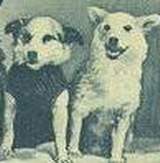
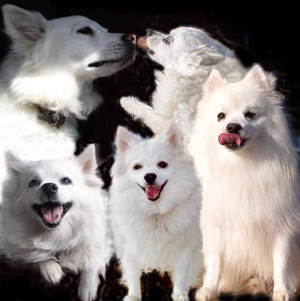
Historical Photo Shows Some Of Our Breed's
Cousins Performing In The Russian Circus
Int Ch Chekia The Kingdom Promise VCX
With Her Eight Week Old
American Eskimo Dog Puppies:
Matthew, Luke, Mark, and JohnJohn
Miniature American Eskimo, Or Japanese Spitz?
The Breeds Are Truly One And The Same
Strelka And Belka, The World's
First Safely Returned Space Travelers
Affectionately Called The "Eskie",
The Breed Is Well Known For
It's Smiling Face, Humor, And Intelligence
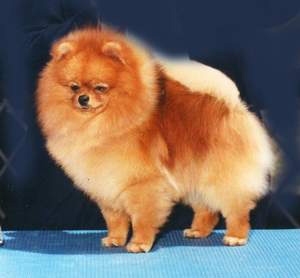
"Figgy" beautifully represents the Pomeranian breed,
also called the "Zwerg Spitz" variety of German Spitz.
He is owned by Judy Paris and Letitia Cannon
bred by Sharon Hanson
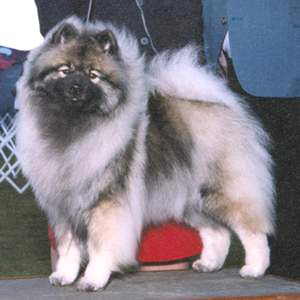
in some countries as the "Wolf Spitz" variety of German Spitz.
She is owned by Rene Sauser and Dennis LeHouillier
bred by Brenda Brookes
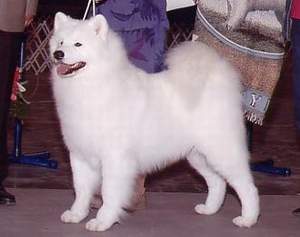
"Chevy" is a beautiful representative of the Samoyed breed, which is NOT a German Spitz breed,
He is owned by Betty & Percy Cline,
bred by Nancy Kraus & Betty Cline
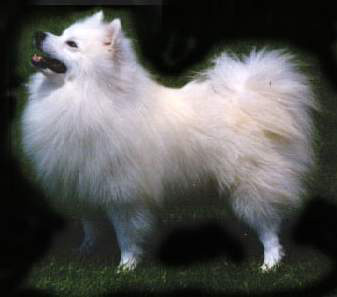
"Casper" is a beautiful representative of the
American Eskimo breed, and you can easily see here
the contrast between a correct Eskie and a correct Samoyed.
Owned by Lynn & Roberta Martin, bred by Shiela Ruzanski
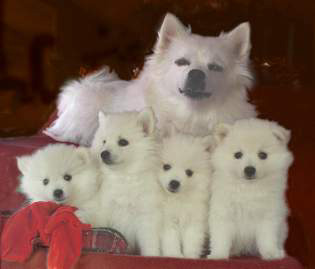
AED History resourced from "The German Spitz" by Ms. Jannat Al-haddad ,
Historical records from the United Kennel Club,
and personal conversations with Nancy Hoffman, author, The New American Eskimo,
and Barbara Benyon, author, The Complete American Eskimo
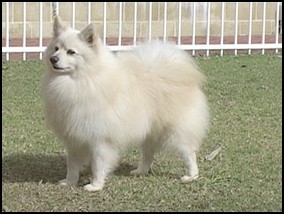
This beautiful representative of the German "Mittel" Spitz clearly shows his relationship to our Standard size AED's,
He was bred and is owned by Fran Hussey-Allen
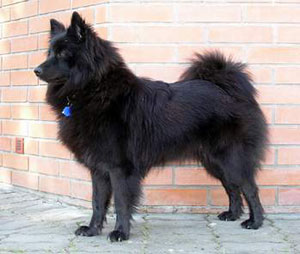
This beautiful representative of the German "Gross" Spitz shows one of the many colour varieties (black)
in which the breed still exhits
His breder is Renata Nociarova Owner: Marketa Smrzova
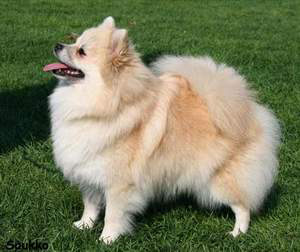
"Maya" beautifully represents the German "Klein" Spitz
from which our mini and toy AED's decended.
She was bred by Niki Allison, Owner Nina Lahin
"Russian Circus" photo above is from the Jorgen M. Christiansen collection,
published by The Circus Historical Society's Bandwagon magazine, May/June 1964 (pg 4)
and is used here with kind permission of it's president, Robert F Sabia
Keeshond photo ("Vicky") appears with kind permission of Rene Sauser
German Gross Spitz photo appears with the kind permission of Marketa Smrzova
German Mittel Spitz photo appears with kind permission of Fran Hussey-Allen
German Klein Spitz photo ("Maya") appears with kind permission of Nina Lahin
Pomeranian photo ("Figgy") appears with kind permission of Judy Paris
Samoyed photo ("Chevy") appears with kind permission of Nancy Kraus & Betty Cline
American Eskimo photo ("Casper") appears with kind permission of Lynn Martin
You may click on the names of these dogs, above, as well as on
"The Russian Circus" and "American Herding Breeds Assn." to visit their respective web sites
You're listening to
"Song Of Spring"
by German Composer
Felix Mendelssohn